 Mesothermal gold deposits form half way up through the rise of the melt from the deep crust to the surface usually at a depth of less than 10 km but greater than 1 km. temperatures at these depths are generally somewhere between 450 degrees and 250 degrees Celsius. The term mesothermal veins is really a sack term, referring simply to the depth formation. It pays little attention to the origin of mineralizing fluids. This group of deposits forms throughout the earth’s long history all the way from the earliest Archean, say more than 3.4 billion years ago right up until today.
Mesothermal gold deposits form half way up through the rise of the melt from the deep crust to the surface usually at a depth of less than 10 km but greater than 1 km. temperatures at these depths are generally somewhere between 450 degrees and 250 degrees Celsius. The term mesothermal veins is really a sack term, referring simply to the depth formation. It pays little attention to the origin of mineralizing fluids. This group of deposits forms throughout the earth’s long history all the way from the earliest Archean, say more than 3.4 billion years ago right up until today.
As I mention these deposits go by several names depending on who you’re talking to:
- Greenstone gold
- Archean lode gold
- Shear zone hosted gold deposits
- Orogenic gold deposits
They are all referred to pretty much the same sort of deposit. Well known example of the group of deposits include:
- Kalgoorlie Super pit in western Australia
- Globe and Phoenix, Zimbabwe
- Campbell Red Lake in Canada
- Giant Yellowknife deposits in Canada
- Ashanti and Obuasi in Ghana
- Hemlo deposits in Canada
- Las Cristina’s in Venezuela
Although somewhat unusual in characteristics the Hemlo deposit in Canada can also be included in this group. The images of the 3D module, of the 3D of the St-Ives mine near Kalgoorlie in Western Australia. The brown shape at the top is a section through the open pit. The other colour represent through the mineral mine shears.
Displaying multiple shears are typical thrust duplex structures that form there in the compression of host rocks and these often act as host to mineralize veins. So how significant are these Greenstone/Orogenic Belt shears zone hosted gold deposit in the grand schemer things? This graph shows the gold grades of various types of deposit mined in Canada. These Greenstone/Mesothermal shear hosted gold deposits are in yellow and you can see that they tend to grade between seven and ten grams per ton.
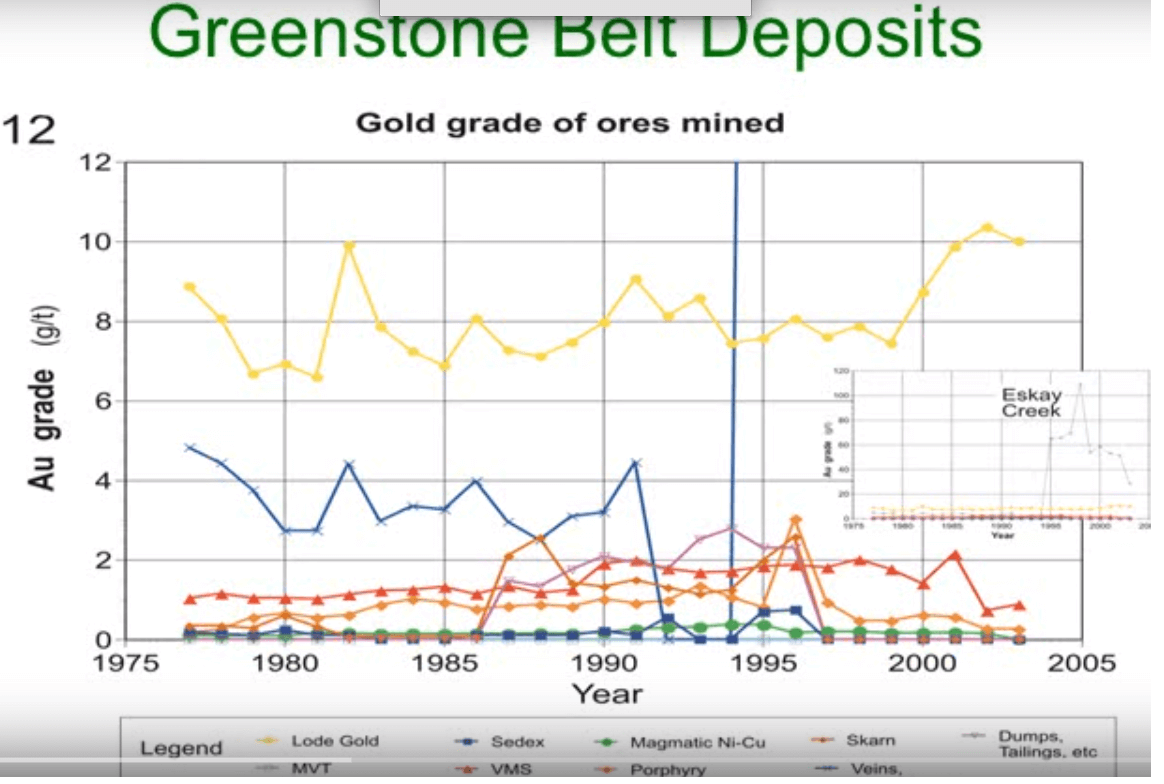 Well above the gold grade of most other deposits types, in a world where greatest came, this is important. So much for grade, what about the volume that gold produced?
Well above the gold grade of most other deposits types, in a world where greatest came, this is important. So much for grade, what about the volume that gold produced? 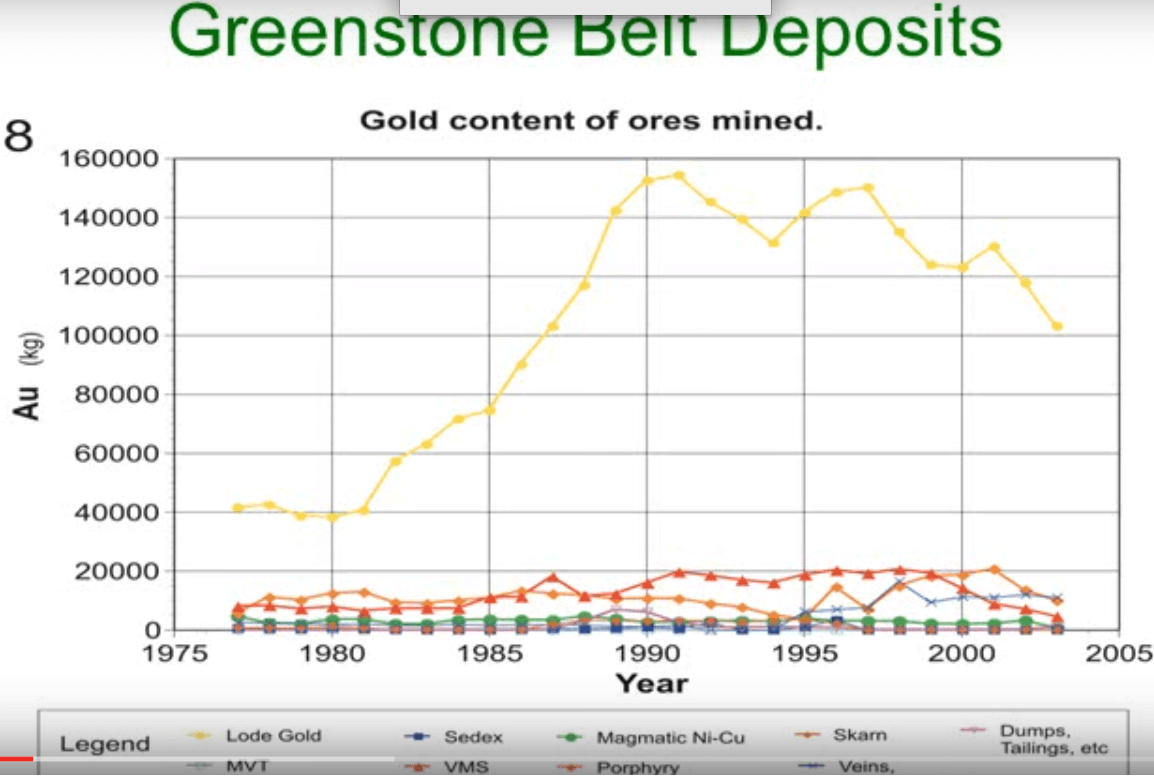 Here again in yellow you can see in Canada the vast majority of gold mine each year is derive from Greenstone/Orogenic belt shears zone hosted gold deposit. This is less striking if we take worldwide production figures in which the gold deposits and Colin type deposits produced more significant proportions.
Here again in yellow you can see in Canada the vast majority of gold mine each year is derive from Greenstone/Orogenic belt shears zone hosted gold deposit. This is less striking if we take worldwide production figures in which the gold deposits and Colin type deposits produced more significant proportions.
But even globally shears zone hosted deposits are major contributors to annual gold production. As we mention mesothermal veins to form from the earliest period of the earth’s history right up until today. However the majority of the greenstone belt gold deposit formed in two main pulses at the end of the Archean and in the early Proterozoic. I.e. around 2.7 billion years ago and 2.1 billion years ago.
Although it sounds a very long time ago, these deposits formed about half way through the earth’s history. And this diagram puts it into perspective. The earth originally formed about 4.6 billion years ago and dinosaurs evolved about just a hundred and fifty million years ago and human barely registered on the scale.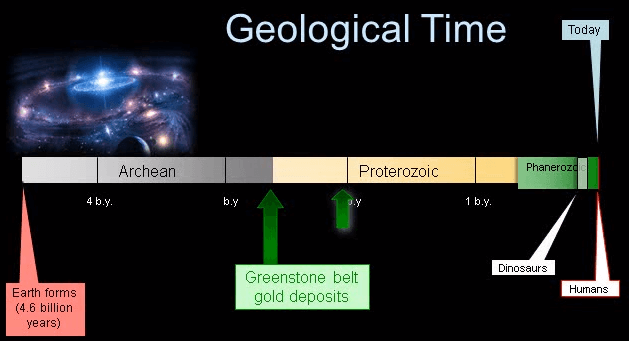
Not all the earth’s crust that was in existence at the time of formation of these deposits. It’s still available, still visible today. Some is been eroded and other part of it is obscured by thick sequences in the youngest elements in volcanic rocks. The figure shows in purple with a remaining portion of the resolve cratons as if the old crust is called, existed today.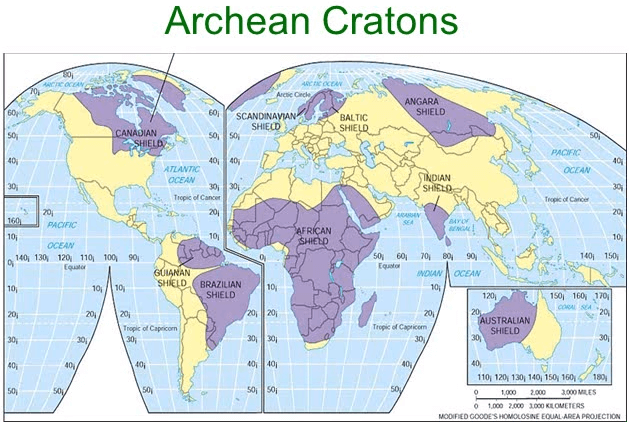 Although major parts of the center are obscured by thin cover rocks. But when you strip away the cover, as is happened in a number of area, you can see that this early crust look very similar wherever in the world you see it.
Although major parts of the center are obscured by thin cover rocks. But when you strip away the cover, as is happened in a number of area, you can see that this early crust look very similar wherever in the world you see it.
This below is a satellite viewed at a typical Pilbara craton in Western Australia. And it gives a good idea of the geological architecture of this old crust. The images covers the area of a 140 kilometers by 10 kilometers.
The area to the south, colored in yellow is the young cover obscuring the underlying Archean craton. The darker greenish coloured areas are the old volcanic and sediments. And you can see why they are referred to as greenstones belt. The pale buff coloured areas are granite-plutons those are risen up and shoulder beside the greenish volcanic rocks.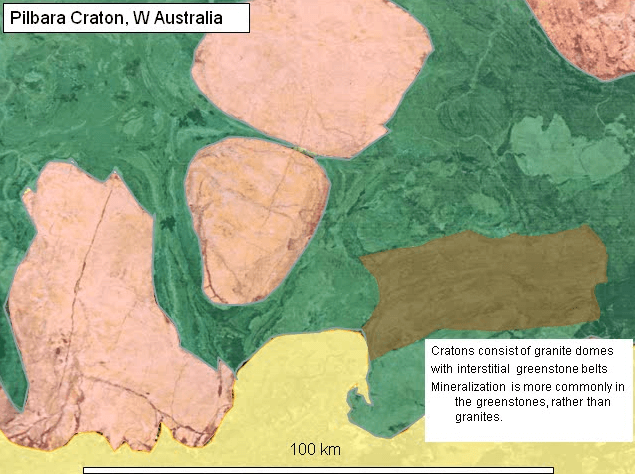
The speckled units in the south east is considered to be part of the Greenstone/Orogenic belt. The comprises pebbled eye conglomerate where the deposited is rising granite plutons for eroded .now you can take almost any part of the old cratons worldwide and they’ll have a similar of types, with the same order formation and the same style of deformation. And I’ll come back to this later in the talk to show how the crust developed and its influence on the gold mineralization.
Mineralizing Process:
Let’s turn to the gold mineralizing process now. All hydrothermal deposits needs three things:
- A source of fluids and metals.
- A a channel way through the crust to transport the metal upward from the source area.
- A trap with a physical conditions change to cause the metals to drop out of the fluid and form the ore deposit.
We’ll start with the source. The source for the gold itself appears to be in a gold rich layer in the deepest portion of the crust, about 20-30 km below surface. This golden rich source area seems to be impartially practically well developed in the Archean crust. Later formed crust is less enriched.
The partial melting of this crust usually triggered by faulting and thrusting of the crust which thickens and pushes it, lower the portions deeper in the underlying mantle where they melt. As describe in my first talk in the geology 101 series the gold is concentrated into the melt portion of the partially melted rocks.  Analysis of oxygen Isotopes and hydrothermal fluids as showing that the water that comes out of that melt is derive from metamorphic and melting up the crust rather than from any deeply penetrating ground water. Many minerals when heated under pressure breakdown to form different minerals and give off water in the process.
Analysis of oxygen Isotopes and hydrothermal fluids as showing that the water that comes out of that melt is derive from metamorphic and melting up the crust rather than from any deeply penetrating ground water. Many minerals when heated under pressure breakdown to form different minerals and give off water in the process.
A channel ways separate from melts for hydrothermal deposit. This is needed to get the gold bearing fluid from the deepest part of the crust up to where something triggers the gold deep position from the fluid. How does it travel? Well gold, as you know is barely soluble in pure water, so it needs to combine with other elements to become soluble. The most common form for gold to travel in, is with chlorine as a chloride complex or sulfa as a fire complex.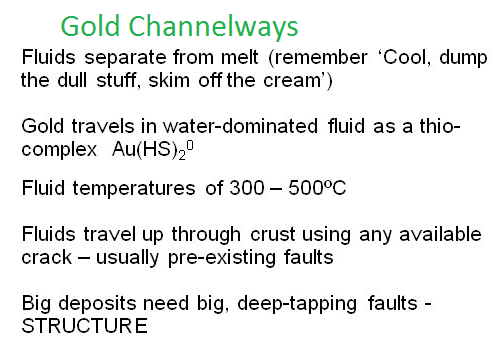
In the case of these shear hosted gold deposits, the gold is transported dominantly as a fire complex with the sulfa. As a fire complex the gold can be carried out at the concentration as much as 10 parts per million. Although the fluids starts off with a higher temperatures study shows that by the time the gold begins the drop out of solutions the fluid’s temperature are between 300 degree and 500 degree Celsius.
In spite of these high temperatures, the fluids are not usually not boiling because of the high confining pressures at those depths. The hot fluids tend to rise and they take the easiest root they can find up towards the surface. The bigger the structure the more fluid it can carry and because we need a lot of fluid to produce a big gold deposit we need to look through the biggest, deepest tapping structures to provide a fluid channel way.
Now we come to the most critical part of the mineralizing process. We’re less concerned about where the gold came from and how it traveled there, we’re more interested in how and where the drop out the fluid to form the deposit. There are several ways to get gold to drop out of the fire complex solution. You can simple cool the fluid which will happen naturally as the fluid rises into rocks, progressively lower temperatures are mixes with cooler groundwater.
But this is not a very effective method. A more effective method is to drop the pressure which will allowed fluid to boil which causes the gold to drop out of solutions. This is an important factor in a thermals deposit but as I said the mesothermals veins they are too deep and too higher pressure for boiling to occur. So more effective ways is to get the gold to deposit in mesothermals veins is by causing the fire complex to break down and leaving the gold with no way to continue its ride to the surface.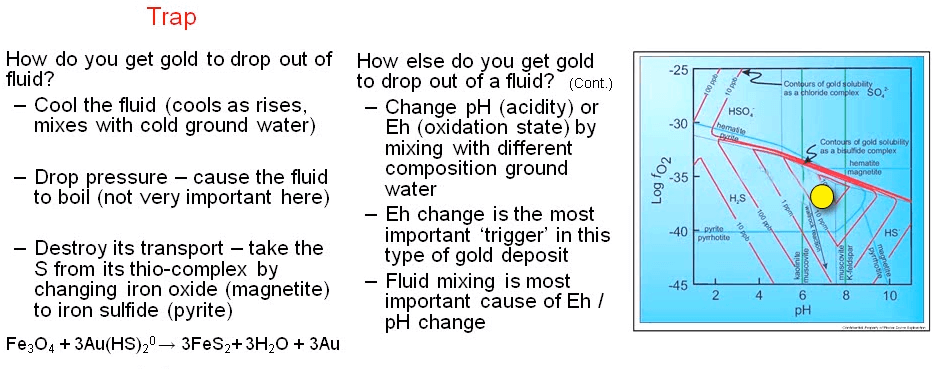
In effect you’re destroying gold taxi and leaving it stranded by the side of the road. How do we do this? Well by reducing iron oxide in certain rocks such as bonded iron formation or mafic volcanic and this reaction ties up the sulfa with the iron to produce iron sulfide or pyrite. It leaves you with native gold. However there is another way and we starting to realize probable the most effective way have causing the gold to drop out the hydrothermal fluid and that’s by changing the EH or oxidation level of the fluid.
Most gold bearing solutions are moderately oxidize and have a neutral PH equivalent to the yellow dot on the graph there. The red lines are contour of gold’s solubility bisulfite complex. If you mix the fluid with the reduce groundwater derive from, for example: the watering shells then suddenly decreasing in EH will cost the solubility of gold to drop to less than one percent of its original value.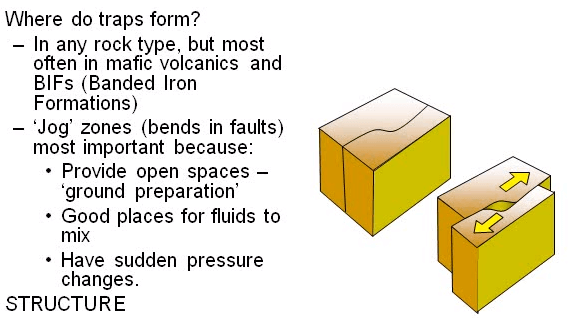
So what, when we are looking for a gold trap, we need to consider where the oxygenated mineralizing fluid is likely to meet to a source of reduced groundwater. Fluid mixing is the most important cause of EH and PH change. In addition to fluid mixing for a trap to be effective you need significant rock damage to allow large veins or dense network of smaller veins to form.
This can occur in virtually any rock type but brittle rock shatter well than plastic or ductile rocks, so mafic volcanic and banded iron formation are more common host than ductile shear. In addition bends or jogs in faults provided great place for open spaces to form and fluid mixing to occur. So again we see the structure plays a critical part in the formation of the trap for the gold.
Structure:
Structure is critical in formation and exploration. The biggest, deepest tapping structure are usually thrust faults which may extend down to the lower crust and provided the main channels for the fluids. This is the seismic sections through the crust and upper mantle northern Ontario in Canada. The boundary between the two is clearly visible and you can see that the mantle has few seismic reflectors in it, as it largely molten.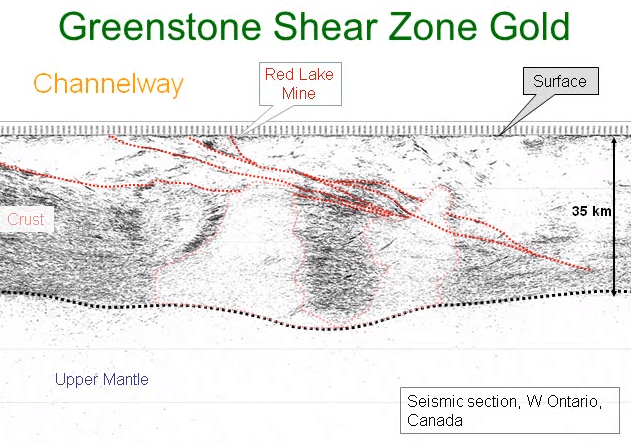
The crust on the other hand is about thirty to five kilometers thick and is much noisier and has a host of reflectors. Clearly visible is a group of thrust faults climbing from the bottom left right to the top left. Also visible are two three areas of the crust with poor reflectance. These represent where the crust was depressed by the thrusting and is undergone partial melting.
They are the source area of the gold buried fluids which traveled up those thrust faults towards the surface and it’s really no surprise that the gold copes outstanding red lake mine, one of the world’s highest grades and lowest cost produces is located on a structures that provided the shortest route to the surface for the fluids.

